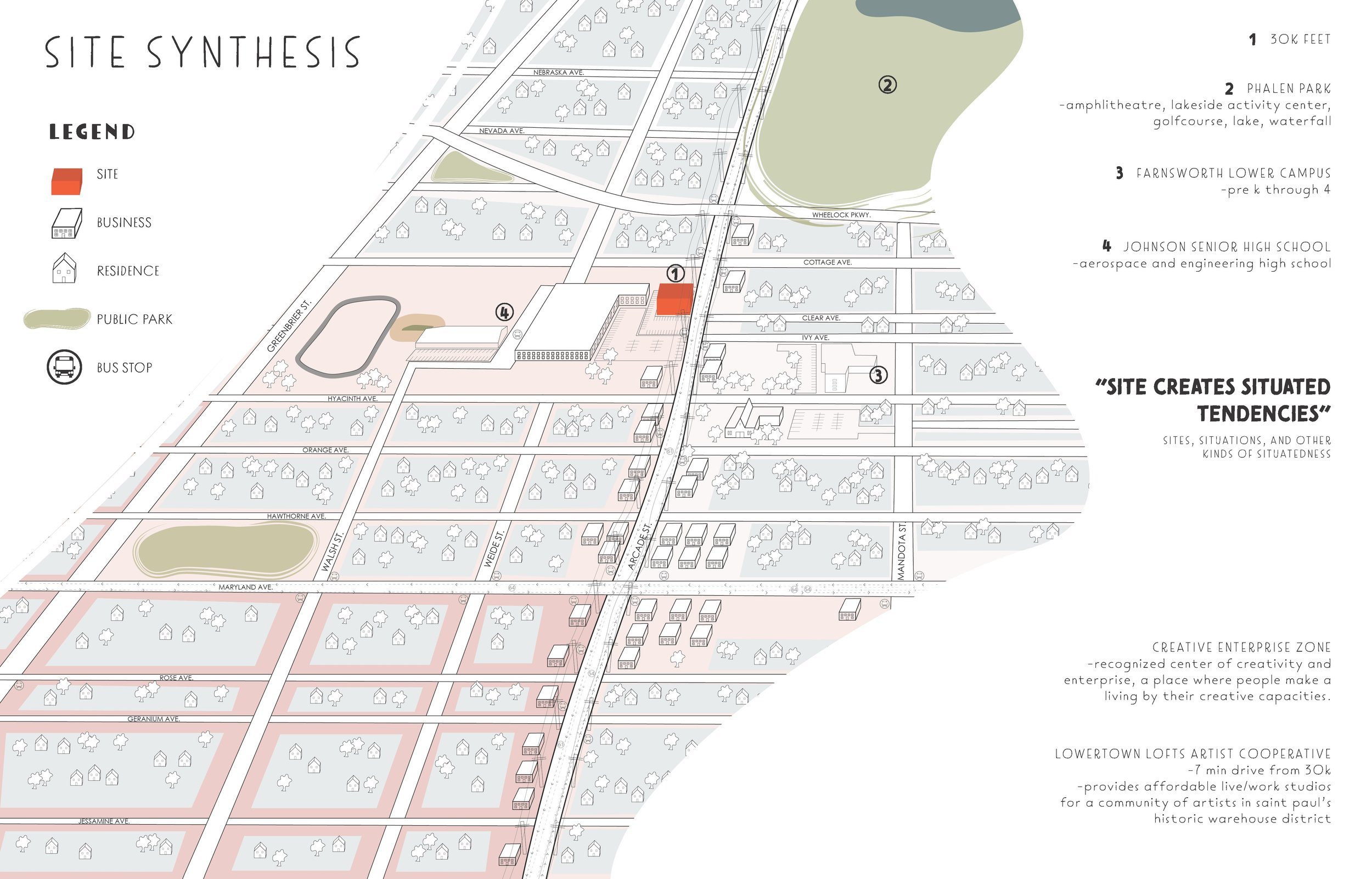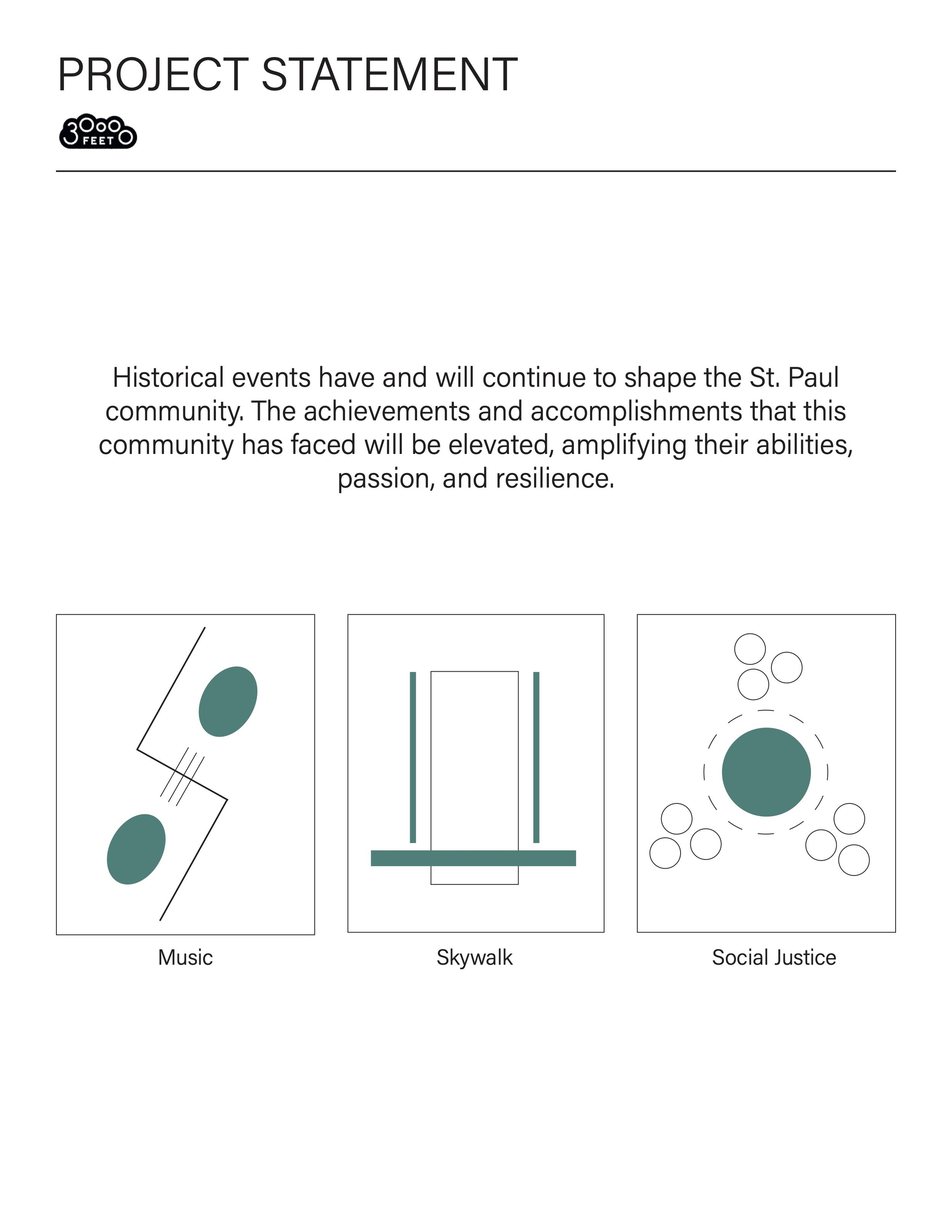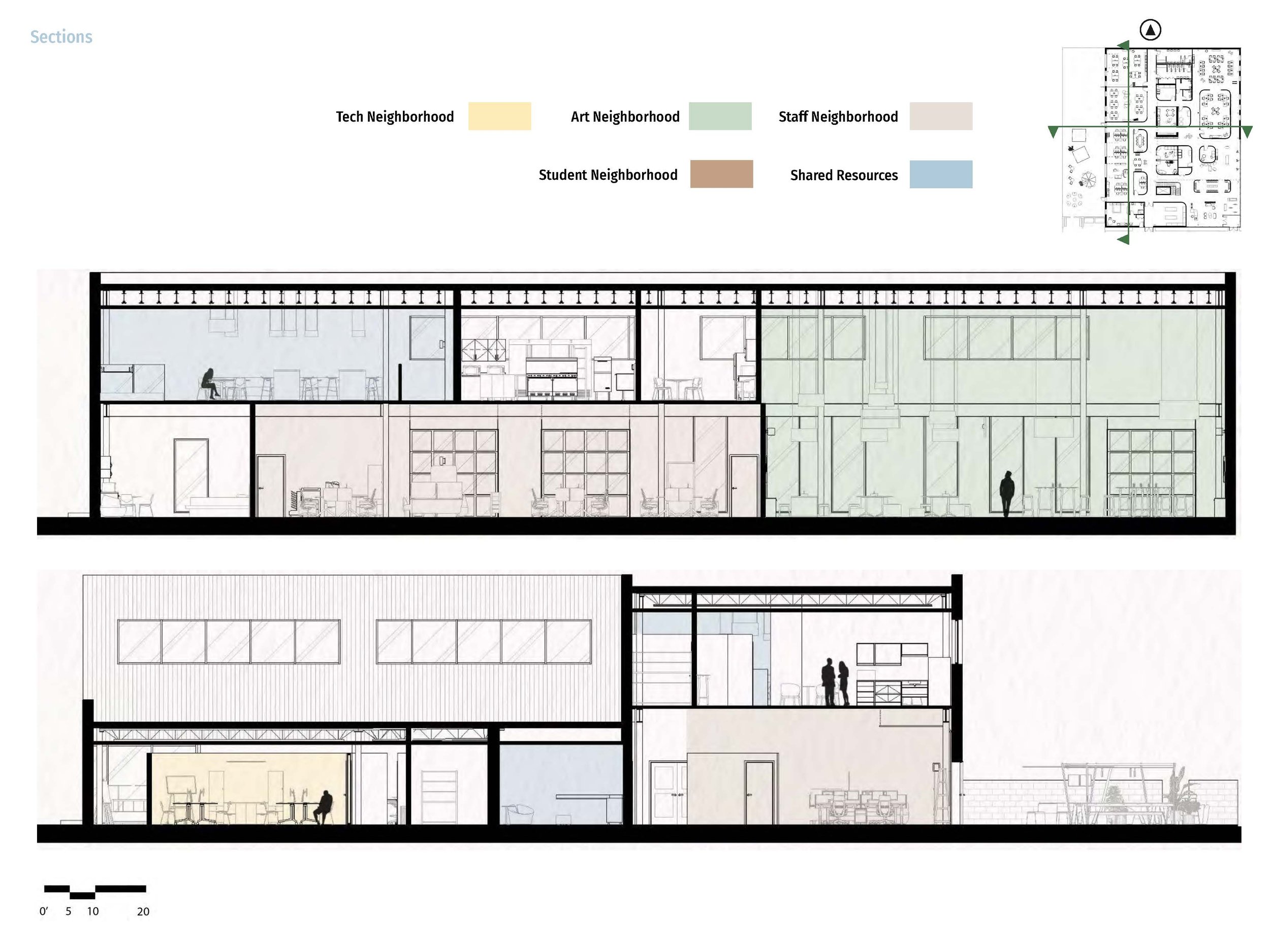Professor Tina Patel
This studio involves understanding, designing, and making for others with different realities and unfamiliar experiences by utilizing contemporary social issues as design problems. Through a participatory and self-reflective design process, students will be challenged to abandon the stability of their worldview to align with those of the end-users in the designed space. The projects and design process will involve constant reflection, understanding, and respect from all participating members, not just the account of one individual’s imaginative projections.
Serene Hawes
30K Feet - Center for Youth Empowerment
This project strives to understand and promote the mission of empowering black youth in Saint Paul, Minnesota. Our client, 30K Feet, strives to impact the Saint Paul community through providing valuable lifelong resources to its scholars, specifically in the Art and Tech world. The final space accommodates for a variety of activities surrounding the art and tech cohorts as well as the needs of the staff and community. Through layers of research and empathy, a space was designed to promote self-actualization through learning and molding a vision of the future for each of these scholars. The space utilizes bespoke furniture and ceiling designs to create wayfinding and a feeling of comfort not usually associated with institutions of learning, promoting flexibility and agency in learning.





Cassidy Tope
Youth Culture & Empowerment Center
The program for 30K Feet celebrates and encourages scholars through providing them agency and building a sense of community. Students learn in various modes and need learning environments to support that, as mentioned in Gardner’s Theory of Multiple Intelligences. The history of the school system is flawed and marginalizes diverse users by not providing these diverse learning styles and Rigid learning structures to push obedience, rather than learning and academic excellence. Education should embrace students, support them, and celebrate them. The rigid traumas faced by this community in the past have to be recognized, and new structures that morph and evolve the black community with hope and embrace have to be implemented. By recognizing various forms of intelligence, design morphs users around their own learning styles, uplifting and creating endless opportunities in a nontraditional way. The wood slats represent harsh, rigid structures of the past, though their flexibility sheds light on a hopeful new future. The slats form Gardner's Multiple Intelligence as methods of learning such as interpersonal, intrapersonal, visual-spatial, and naturalistic intelligence. Intrapersonal learning comes in moments of morphing retreat and exclusion. Interpersonal learning focuses on creating community interaction and seating through the morphing slats. Visual-Spatial and logical intelligence morphs from the retractable slats that provide writing surfaces or graphics. Naturalistic learning is morphed into the program by vegetation planters and connections to natural materials. By providing choices to the scholars in how they learn, the program caters to a variety of learners while providing nontraditional forms of learning many scholars don’t normally have access to.





Olivia Mansier
Cultural Youth Empowerment Center
A learning environment should be a place of domination and appropriation which serves the needs of all learners regardless of their backgrounds, providing an avenue for democratic thinking and learning. The goal of this project is to empower and liberate the scholars of 30,000 Feet. This liberation will come from the spatial strategy of density. Dense environments carry connotations in the built environment – on one side they are considered positive due to the sustainable use of resources and the intense social links they generate, but on the other side they are recognized to generate negative effects on humans, such as stress. Density is leveraged in this project to create intense social links, empowerment and communication among scholars and less dense moments provide opportunities of learning, privacy and liberation. The variations of density will all hold a different methodology of interaction. The in-between moment will allow people to engage with one another and their space, giving them agency. When a moment gets dense, that is where the destination and meaningful exchange takes place.






Emma Weaver
30,000 Feet: Youth Empowerment Center
Through this project, we will have an opportunity to study the historical and contemporary racial disparities in the school system in St. Paul, MN. We will partner with Studio BV, a design firm in Minneapolis, and 30,000 (30K) Feet, a nonprofit that offers academic support services and culturally appropriate assistance to African-American kids. They started with a dream of empowering African American students through culture, art, technology, and social justice and is now a cultural youth movement for boundless learning: navigating a collection of creative experiences to propel lives forward. Students will have the opportunity to learn from Studio BV and 30K Feet, about the space needs, explore the challenges and opportunities of the site and context, and research the role of these typologies as community incubators. Working individually, students will develop a conceptual design for the fit-out of the space that incorporates their client’s needs. You will develop an understanding of the position of African American youth in segregated communities, existing school systems and education policies, the lack of after-school programs, and a thorough understanding of the mission, vision, and goals of 30K Feet. You are required to research and explore these issues, develop deep empathy for the scholars, their circumstances, and sensory needs and provide a sensitive and empathetic design solution that would instill discipline, self-pride, and self-confidence, through self-expression and discovery.






Professor Ronn Daniels
Across the United States, suspension rates of Black students are two to three times higher than those of other racial and ethnic groups. Moreover, rigorous research documents that Black students remain over-represented in school discipline sanctions after accounting for their achievement, socioeconomic status, and teacher-and self-reported behavior. Black students, who made up 26 percent of Twin Cities district enrollment, received about 73 percent of out-of-school suspensions in 2019-20, according to reports to the Minnesota Department of Human Rights, which is monitoring the district’s discipline data. Is this the outcome of implicit biases or rigid education policies, or is it tied to greater and crucial socio-political issues such as systemic and intentional racism, segregation, and redlining? Through this project, we will have an opportunity to study the historical and contemporary racial disparities in the school system in St. Paul, MN. We will partner with Studio BV, a design firm in Minneapolis, and 30,000 (30K) Feet, a nonprofit that offers academic support services and culturally appropriate assistance to African-American kids. With a diverse staff and a board of directors who share experience in youth development, 30K embodies an unwavering dedication to the St. Paul community. They started with a dream of empowering African American students through culture, art, technology, and social justice and is now a cultural youth movement for boundless learning: navigating a collection of creative experiences to propel lives forward. Working individually, students will develop a conceptual design for the fit-out of the space that incorporates their client’s needs. You will develop an understanding of the position of African American youth in segregated communities, existing school systems and education policies, the lack of after-school programs, and a thorough understanding of the mission, vision, and goals of 30K Feet. You are required to research and explore these issues, develop deep empathy for the scholars, their circumstances, and sensory needs and provide a sensitive and empathetic design solution that would instill discipline, self-pride, and self-confidence, through self- expression and discovery.
Megan Kinsey
30,000 FT Youth Cultural Empowerment Center
This approach to the Youth Cultural Empowerment Center reflects the intersection of neighborhood. The social, cultural, and racial implications of this project required a unique approach to the scale of its urban context. Stoops, Sidewalks, & Cornerstones offered insight into the organic forms of gathering that arise within the city. Physical model making furthered this study of form, with complimentary diagrammatic illustrations that informed both the plan and sections of the space.










Sarah Price
Carved Mass
In this project I designed for 30,000 Feet, an after school program and community center, based in St. Paul, Minnesota. They have two programs, an art and literacy program and a tech program, that occur after school. During the day, the space focuses on community outreach. When researching the typology of education buildings, I discovered that there has been a rise in prison-like buildings that focus on control and surveillance rather than comfort and education. This has a negative impact on the education and mental health of the students. In my space, I focused on flexible spaces, carving as a method of developing space, and the scale of home. Through the act of carving the public and private spaces will become delineated. As the river carves its own path through the stone, shaping it as it evolves, the space will be continuously carvable, allowing it to grow and change with the user’s needs. As I developed this concept, I started to explore ways of making mass forms out of planar materials, and how to carve out niches of space in that mass. I reduced ceiling heights to create an experience of mass and mirror the scale of a residential space to make the user more comfortable. Benches and niches are carved out, including a carved space on the exterior to allow the public to occupy space without putting the safety of the children at risk. The second level is cut away in areas to reveal the mass below. The carved elements of the masses in the space, and cutaways in the second floor help further the idea that the planar objects are solid, and create a comfortable, grounding space, ideal for learning.









Katie Gagle
Defining Assembly
St. Paul is a very passionate community that is made up of several significant moments and features that make the city unique. To elevate their resilience and determination, the space will incorporate several moments, divided into zones. These are labeled as Minneapolis Sound, Social Justice, and Skyways. These each are significant to Minneapolis, impacting the community very closely. Each zone is designed differently, playing with materials, textures, and architectural features to guide users through the space. Minneapolis Sound plays with bold color, patterns, and large structures that reflect the popular R&B funk music. Listening booths are integrated to allow scholars to be connected to their community. The Social Justice zone uses durable, strong materials and a way to gather in a space, just as individuals cluster to protest. The Skyways are integrated into the co-working hub. Elevated on the second floor, they serve a purpose to create a space for collaboration to share ideas and communicate. As a main focal point, a dynamic angle through the center of the plan directs users playing on their forward thinking and determination to make change.










Abrielle Harrison
30k Youth Multicultural Center
There is power in collaboration. Sharing knowledge and experiences leads to greater understanding and inclusion. Communities need spaces that foster sideways collaboration and support to promote solidarity and ensure future prosperity. The 30k Youth Multicultural Center will foster growth through the promotion of collaboration by exploring connection between both the spaces and people within. Collaboration of a variety individuals in the community not only provides support and ensures growth for the current community but for the future as well. The community as a whole can grow as well as the individuals who will be the future generation. Propagating growth can provide multigenerational change.





Professor Dalton Kline
This studio involves understanding, designing and making for others with different realities and unfamiliar experiences by utilizing contemporary social issues as design problems. Through a participatory and self-reflective design process, students will be challenged to abandon the stability of their worldview to align with those of the end users in the designed space. The projects and design process will involve constant reflection, understanding and respect from all participating members, not just the account of one individual’s imaginative projections.
Megan Faina
Youth Culture Empowerment Center
The use of exposure by subtraction and nesting within the freedom of path creates a supportive and secure environment that fosters youth empowerment. Independence encourages youth to make their own choices through self expression. Orange tones promote ambition while the blues establish a connection to the water elements in the surrounding environment of St. Paul.








Elizabeth Vernon
Heart of The Space
As racial disparities in school discipline have grown in U.S schools, suspension rates of black students are two to three times higher than those of other racial-ethnic groups. We are partnering with studio BV and 30k feet a nonprofit that offers support to African-American kids in St. Paul Minnesota. Together, we will design a space where kids can start and continue to empower African-American students to find their voice and passion. By creating an organization of networks to plug in to receive security and empowerment. To use relationships as circuits to create a continuous feed to charge/recharge its users. 30k family energy fosters the power to bring life to the HEART of the space. Creating an environment that feeds off of empowerment will spark the network of relationships within the space.





Meghan Liddy
30,000 Feet - Youth Culture and Empowerment Center
Through this project, we will have an opportunity to study the historical and contemporary racial disparities in the school system in St. Paul, MN. We will partner with Studio BV, a design firm in Minneapolis, and 30,000 (30K) Feet, a nonprofit that offers academic support services and culturally appropriate assistance to African-American kids, ages 5 to 18. Around 250-300 youth participate in these programs (not including the programs in schools and libraries), at no cost. With a diverse staff and a board of directors who share experience in youth development, 30K embodies an unwavering dedication to the St. Paul community. They started with a dream of empowering African American students through culture, art, technology, and social justice and is now a cultural youth movement for boundless learning: navigating a collection of creative experiences to propel lives forward. The strategy for the project centers on the concept of individual neighborhoods that can come together with shared resources. The strategy is to enable an empowered future and showcase culture through multiple commonalities.






